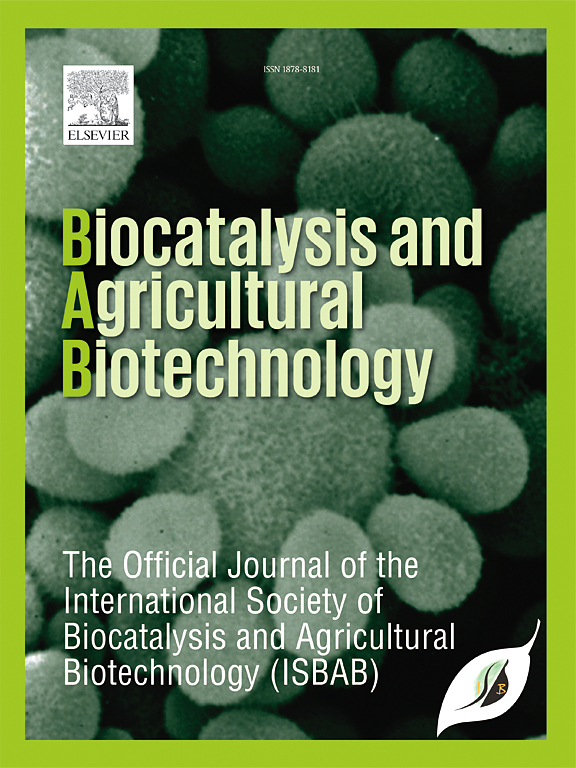Effect of subcritical water extraction and precipitation methods on the functional properties, antioxidant activity, and ACE1 inhibition of palm kernel cake protein
IF 3.4
Q2 BIOTECHNOLOGY & APPLIED MICROBIOLOGY
引用次数: 0
Abstract
Protein is an essential macronutrient for human and animal nutrition. Plant protein sources can be classified into protein flours, protein concentrates, and protein isolates, each offering beneficial nutritional and functional properties. This study investigated the use of subcritical water (SCW) for extracting protein from palm kernel cake (PKC). SCW extraction was carried out at three temperatures (120, 150, and 180 °C) and two durations (15 and 30 min). These conditions were compared with a conventional alkali (2 M NaOH) extraction method. Two protein precipitation methods; isoelectric (pH 3.5) and cold ethanol (80 %), were investigated. Temperature and time significantly influenced protein yield. At 150 °C and 30 min, SCW extraction followed by cold ethanol precipitation resulted in the highest protein yield of 66.24 ± 4.22 %. Isoelectric precipitation under the same SCW condition gave only 1.33 ± 0.06 %. Conversely, the alkali method showed a higher protein yield (94.01 ± 3.99 %) via isoelectric precipitation. Cold ethanol precipitation with alkali extraction was less than 0.01 %. The protein content from SCW extraction was 42.01 ± 1.72 % (flour), while that from alkali extraction was 65.53 ± 1.15 % (concentrate). SCW protein flour showed higher antioxidant activity by DPPH (78.74 ± 2.33 μmol TE/g) and total phenolic content (190.43 ± 1.75 mg GAE/g). However, alkali protein concentrate had higher ABTS (87.88 ± 0.90 μmol TE/g) and reducing power (0.39 ± 0.05 μmol TE/g). SCW protein flour demonstrated the strongest ACE1 inhibition and favorable emulsifying, foaming, and absorption properties. These findings emphasize SCW extraction as an eco-friendly strategy for obtaining bioactive protein from PKC with potential applications in functional foods.
亚临界水提取和沉淀法对棕榈仁饼蛋白功能特性、抗氧化活性和ACE1抑制的影响
蛋白质是人类和动物营养中必需的大量营养素。植物蛋白来源可分为蛋白粉、浓缩蛋白和分离蛋白,每一种都具有有益的营养和功能特性。研究了利用亚临界水(SCW)从棕榈仁饼(PKC)中提取蛋白质。在三种温度(120、150和180°C)和两种持续时间(15和30 min)下进行SCW提取。并与常规碱(2m NaOH)萃取法进行了比较。两种蛋白质沉淀方法;等电(pH 3.5)和冷乙醇(80%)。温度和时间对蛋白质产量有显著影响。在150°C, 30 min条件下,SCW提取后冷乙醇沉淀,蛋白得率最高,为66.24±4.22%。在相同的水冷条件下,等电降水只占1.33±0.06%。碱法等电沉淀法的蛋白质得率为94.01±3.99%。冷乙醇沉淀-碱萃取-含量小于0.01%。石蜡提取液的蛋白质含量为42.01±1.72%(面粉),碱提取液的蛋白质含量为65.53±1.15%(精料)。SCW蛋白粉对DPPH(78.74±2.33 μmol TE/g)和总酚含量(190.43±1.75 mg GAE/g)具有较高的抗氧化活性。碱蛋白浓缩物具有较高的ABTS(87.88±0.90 μmol TE/g)和还原力(0.39±0.05 μmol TE/g)。SCW蛋白粉对ACE1的抑制作用最强,具有良好的乳化、发泡和吸收性能。这些发现强调了SCW提取是一种从PKC中获得生物活性蛋白的环保策略,在功能食品中具有潜在的应用前景。
本文章由计算机程序翻译,如有差异,请以英文原文为准。
求助全文
约1分钟内获得全文
求助全文
来源期刊

Biocatalysis and agricultural biotechnology
Agricultural and Biological Sciences-Agronomy and Crop Science
CiteScore
7.70
自引率
2.50%
发文量
308
审稿时长
48 days
期刊介绍:
Biocatalysis and Agricultural Biotechnology is the official journal of the International Society of Biocatalysis and Agricultural Biotechnology (ISBAB). The journal publishes high quality articles especially in the science and technology of biocatalysis, bioprocesses, agricultural biotechnology, biomedical biotechnology, and, if appropriate, from other related areas of biotechnology. The journal will publish peer-reviewed basic and applied research papers, authoritative reviews, and feature articles. The scope of the journal encompasses the research, industrial, and commercial aspects of biotechnology, including the areas of: biocatalysis; bioprocesses; food and agriculture; genetic engineering; molecular biology; healthcare and pharmaceuticals; biofuels; genomics; nanotechnology; environment and biodiversity; and bioremediation.
 求助内容:
求助内容: 应助结果提醒方式:
应助结果提醒方式:


